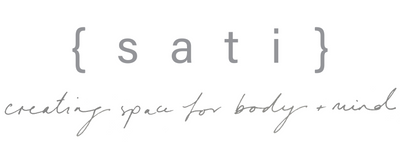
Harnessing nature through plant dyes. Every part of our process is slow, considered and close to nature. Here is Shivraji dyeing some of our ‘burnt pink’ fabric in a solution made from seed husks.
Blogger and content writer Bethany Allen came to find us recently to discover what Sati was all about. She wrote the following article about what we do, highlighting the value of our natural processes and why these are integral to our mission.
“Sati Design unites Scandinavian simplicity with natural dyeing techniques, heralding from the sun baked earth of India. Born from a desire to create a range of meditation cushions that are functional and fashionable; Sati is a business in its fledgling phases, but already it’s clear that it has the potential to fly.
I was fortunate to meet with founder, Claire Thorp, to learn the story behind Sati. Her calm demeanour is complemented by bright eyes that are full of ideas. Pursuing meditation has defined Claire’s path in life. It led her to discover the practice of Vipassana, and it also led to the moment Sati was fabricated. “I was in Indonesia when the idea to create a range of meditation cushions took root,” Claire tells me with a smile. “I met a couple who create beautiful prayer mats and it made me dwell on the market for meditation cushions and how there is a very limited choice of designs.” Claire was inspired to remedy this and design her own range of cushions. “As soon as I had this small thought, it was like I hit the download button - I had visions of what the website would look like and all the other products that could accompany the cushions. After I finished meditating, I got out my notebook and wrote it all down; it’s the closest thing to a lightbulb moment I’ve ever experienced.”




I was surprised and delighted to learn that a key ingredient in their block printing process is one of the planet’s most valuable assets - mud. Claire explains: “On the whole we use mud to print with, it’s combined with tree gum and limestone but essentially it is earth and water. The block is covered with its muddy paste and pressed onto the fabric, this is then set aside in the sun; once dry, it is dipped into a bath of natural dye. For instance, we will make up a bath of pomegranate rind and water, which results in the sunshine yellow. When the fabric is dunked, the mud acts as a resistant to the dye and beneath its shield, the bare cotton remains intact whilst the rest of the fabric changes colour around it. The next step is to wash the fabric and this is when we can remove the mud and witness the finished effect of our dyed fabric, contrasting against the bare cotton.”




It’s fascinating to learn about nature’s colour palette and discover that you don’t have to rely on chemical inks to create vibrant and beautiful patterns. I learned that to dye fabric black (or grey), Sati uses iron. Every piece of fabric is produced using natural substances such as these. “All of this is done in India,” Claire tells me with bright eyes, “just outside Jaipur in a small village called Bagru. The village is famous for its natural dyeing heritage. It’s small and very rural. Luckily we met some people who were able to initiate us into the world of natural dying, it’s a very complex science; some families have been doing it for generations.” The sense of adventure that accompanied Sati’s conception is tangible and as we continue our discussion I can tell that Claire has touched on a lost art. An art that we in the Western world rarely see thanks to the prevalence of fast fashion and even faster fabrics. Sati allows us to sit still and contemplate the world and how to support it better, just as the cushions support our posture.




“We are very grateful to have been welcomed into the community and shown how to carve the wooden blocks and learn about the different dyeing methods.” Even though Claire was shown how to do the process, she didn’t take this knowledge and leave India, she decided to keep the production of the fabrics within the rural community, in the hope that the business would help support them and keep the industry alive. This is one reason why production remains within India, the other is that natural dyes are specific to the region or country within which they are created. “It depends on the resources that are available,” Claire tells me calmly. “We developed all our designs from a colour palette which stems from India. We are also really keen to support our suppliers alongside a charity which is based in the area.” The charity Claire is referring to is called ‘I India’ and it operates within the region where the natural dyeing takes place, supporting street children and women in and around Jaipur.
Sati gives new meaning to the concept of the circular economy. Maintaining a thread of support from the production of the fabric and the communities they stem from; to the cushions themselves. The fabric captures the richness of the earth and the power of the sun in its creation, allowing you to be more connected to the natural world as you sit in meditation.”
You can find out more about Bethany Allen and her work here www.bethanyallen.co.uk


Leave a comment